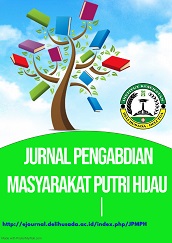PENYULUHAN MANFAAT PENUNDAAN PEMOTONGAN TALI PUSAT PADA BAYI KEPADA IBU HAMIL
Abstract
The main causes of neonatal mortality are prematurity, complications related to childbirth, namely asphyxia and infections and birth defects. When in the womb, the baby's body system depends on the mother. At this time the fetus will get oxygen from the mother. When the baby is born into the world, then the umbilical cord is cut, automatically the dependence on the mother stops. Whether or not the function of the organs is measured by an assessment or test called the APGAR test. Assessment of the general condition of the baby is assessed one minute after birth and then 5 minutes after the baby is born. The World Health Organization (WHO) itself is now issuing guidelines related to clamping and cutting of the newborn's umbilical cord. A delay in clamping of the umbilical cord of more than 120 seconds is recommended to improve the degree of LBW health and nutrition in the baby. Central delay can improve the APGAR value in infants and affect hemoglobin (Hb), hematocrit (Ht) levels, increase blood volume or erythrocytes, so as to prevent hypovolemia and hypotension in low birth weight. However, this has not been widely socialized to pregnant women, especially in the third trimester. which is nearing labor. The purpose of this activity is to provide education to pregnant women about the importance of delaying the clamping of the baby's cord during childbirth. The method of implementing this activity is socialization to pregnant women about delaying cord clamping to prevent asphyxia in newborns.
References
Andersson, O..( 2013). Effect of Delayed versus Early Cord Clamping on Healthy Term Infants. Digital Comprehensive Summaries of Uppsala Dissertations from the Faculty of Medicine 893
Dainty Maternity,AchmadFarich, Gusmiyani. (2015). Perbedaan lama penjepitan tali pusat terhadap kadar haemoglobin (Hb) bayi baru lahir di rumah sakit daerah Mayjend.HM. Ryacudu Kota bumi Lampung Utara. Jurnal KebidananVol 1, No.3, Oktober 2015:148-154.
Destariyani E. (2016). “Pengaruh Penundaan Pengkleman Dan Pemotongan Tali Pusat Terhadap Kadar Zat Besi Bayi Baru Lahir Di BPM Kota Bengkulu Tahun 2015”.Jurnal Kesehatan Almuslim, Vol.III No.3, Agustus.
Hutton EK & Hassan ES.Late vs Early Clamping of the Umbilical Cord in Full-term Neonates.Systematic Review and Meta-analysis of Controlled Trials. JAMA.2017;297: 1241-1252 57
Jiffy WW. (2017). “kontroversi dalam penjepitan tali pusat pada proses persalinan”. Tesis.
JNPK-KR. (2012).“ Pelatihan Klinik. Asuhan Persalinan Normal. Asuhan Esensial, Pencegahan Dan Penanggulangan Segera Komplikasi Persalinan Dan Bayi Baru Lahir”. Buku.
Judi JE,SpOG(2013).”Mempersiapkan Persalinan Sehat”Jakarta Puspa Swara.
Kementerian Kesehatan RI.2016.Profil Kesehatan Indonesia. Jakarta
Llewellyn-Jones, D. 2015.Dasar-DasarObstetridanGinekologi. Jakarta: Hipokrates
Masudik, Dkk. (2016) Panduan maternal and neonatal emergency life support. Bekasi: GADAR Medik Indonesia.
Nuriah.Perbedaan Kadar Hemoglobin dan Hematokrokit Bayi Baru Lahir Akibat Perbedaan Waktu Penjepitan Tali Pusat. Jurnal Kesehatan Andalas: Vol.5 No1; 2016.
Oxorn H & William R (2015).Ilmu Kebidanan ,Patologi &Fisiologi Persalinan,Yogyakarta: Yayasan Essentia Medika (YEM)
Philip AGS dan Saigal S. (2014).“ when should we clamp the umbilical cord? Neo reviews”.
Prawirohardjo S. (2014). “ Ilmu kebidanan”. Jakarta: Penerbit Yayasan Bina Pustaka.
Rafika.(2018).“Waktu Penundaan Pengkleman Tali Pusat Berpengaruh Terhadap Kadar Haemoglobin Pada Bayi Baru Lahir”.Jurnal Kesehatan, Vol. 1 No. 2, April.
RatnasariL, dkk. (2013).“Pengaruh Persalinan Lotus Birth Terhadap Lama Pelepasan Plasenta, Lama Pelepasan Tali Pusat Dan Keberhasilan Bounding Attachment”.Jurnal Kebidanan, Vol. V, No.2, Desember.
Saifuddin AB.(2014).”Buku Panduan Praktis Pelayanan Kesehetan Maternal dan Neonatal”.Jakarta : PT BinaPustaka.
WHO. 2014. Guideline: Delayed umbilical cord clamping for improved maternal and infant health and nutrition outcomes. Geneva: World Health Organization; 2014from:http://www.who.int/nutrition/publications/guidelines/cord_clamping/en
Widdefrita,Mariati. (2015). “Pengaruh Pendamping Persalinan Terhadap Apgar Score Bayi Menit Pertama”.Jurnal Ipteks Terapan, Juli.












